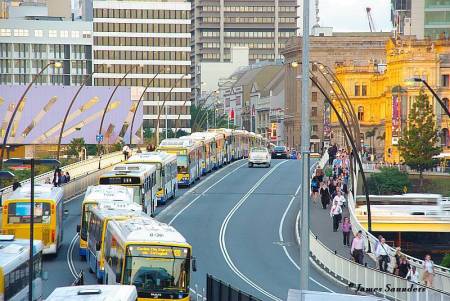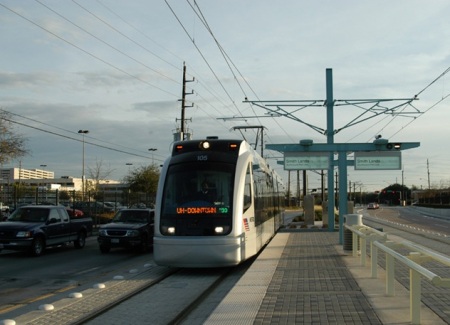
No urban rail on Guadalupe-Lamar? Then get ready for bus lanes…
18 October 2013
Ottawa’s “BRT” Transitway delivers a “conga line” of buses onto urban streets. Photo: Errol McGhion.
♦
by Dave Dobbs and Lyndon Henry
Which kind of transit — urban rail or buses in special lanes — do you want to see on Guadalupe-Lamar?
Not to decide is to decide.
It’s crucial that Austin’s first urban rail (starter) line be a whopping success. This means it must serve the heart of the city in its heaviest-traffic corridor, with its highest densities and employee and employment concentrations, and its most long-established neighborhoods. The Guadalupe-Lamar corridor offers the ideal alignment for an affordable, cost-effective surface light rail alignment.
It’s also important to understand that if we don’t get light rail transit (LRT) on Guadalupe and North Lamar, we most certainly will get dedicated bus lanes within the next 10 years. A major project to overhaul the corridor by installing infrastructure for battalions of MetroRapid buses is waiting in the wings if urban rail is not implemented. This alternative, not requiring a public vote, would produce a far less efficient, adequate, and attractive system, seriously degrade urban conditions, and result in a less livable environment compared with urban rail.
This package of so-called “Bus Rapid Transit” (“BRT”) projects — whereby MetroRapid buses would enter stretches of dedicated bus lanes, and then merge back and forth, into and out of mixed general traffic — was first raised publicly in a Project Connect/City of Austin Transportation Department presentation made in City Council chambers on 25 May 2012 to the CAMPO Transit Working Group (TWG). Shown below is page 10 of that presentation, with arrows pointing to the relevant information.

Excerpt from Project Connect presentation in May 2012 indicating planned $500 million package for MetroRapid “BRT” facilities, including Guadalupe-Lamar. Graphic: Project Connect.
These dedicated lanes will be built with 80% federal money, will not require an election, will be vetted publicly only at art gallery-style “open houses”, and approved by boards and commissions, the Capital Metro Board, and the Austin City Council, and then they will be built, unless we implement urban rail in the Guadalupe-North Lamar corridor. And keep in mind that — unlike the current minimalist MetroRapid project — this level of hefty physical investment in roadway infrastructure will become a de facto obstacle to any future rail project in the corridor.
These dedicated bus lanes are the official plan as things currently stand.
There are numerous drawbacks with premium buses, and even “BRT”, compared with LRT. Just to cite a couple:
• LRT on average is significantly more cost-effective than bus operations.
• Buses don’t attract nearly as much ridership as LRT, but as ridership starts to reach higher volumes, bus traffic and overwhelming “conga lines” of buses cause more problems … plus more queues of riders start to slow operations.

Brisbane, Australia: More “conga lines” of buses travel on reserved lanes between the city’s downtown and a busway. Photo: James Saunders.
If you would prefer urban rail instead of a major bus lane project in Guadalupe-Lamar, it’s essential to speak up and act. Let neighborhood groups and other community organizations know what official plans have in store for this corridor. Sign petitions being circulated to support urban rail on G-L. Communicate to Project Connect and members of Austin City Council that you want to ride urban rail on Guadalupe-Lamar, running in reserved tracks, not just a souped-up bus service weaving in and out of special lanes.


I’m all for urban rail. But a few critiques….
[1]
Urban rail will require its own dedicated lane as well (and if you’re not giving it a dedicated lane, you’re doing it wrong). Of course, unlike a “conga line” of buses, it won’t be weaving in and out of the other lanes. However. that’s a doubled edges sword. If something does get in way of the rail vehicles, they’re stuck. See the photo linked below:
http://www.tripplannermag.com/wp-content/uploads/2012/04/Toronto-Star-Photo-Blog.bmp
[2]
The two “conga line” examples shown above are vastly different from the currently proposed Metro Rapid system. In those systems bus routes from all over the city feed into that single corridor through downtown. It’s essentially what you have downtown right now already minus bus lanes.
However, unless Capital Metro starts operating all sorts of bus routes along this corridor into downtown, you’re not going to get anything much worse than the 101 passing the 1L/M – a few buses bunched together at most – outside of downtown.
Jeff, Thank you for pointing out the desirability of dedicated lanes for urban rail and be assured that both the Texas Association for Public Transportation and the Central Austin Community Development Corporation plans call for repurposing two vehicle travel lanes in the Guadalupe/ North Lamar corridor for light rail service.
In contrast, the Project Connect “Only go to Mueller rail plan” is, like Toronto, a mixed traffic operation. Our apologies for any confusion about this.
Find the alternative plans at:
https://austinrailnow.wordpress.com/tag/alternative-plan/
Our point is that come what may, in the relatively near future, two vehicle lanes will be effectively eliminated in the G-L corridor, either as dedicated rail or bus lanes or simply by the steady addition of more and more buses until, effectively two lanes are consumed. Put another way, Capital Metro and the City plan to greatly expand, upgrade the MetroRapid service from just another limited bus service to something faster and far more frequent on the two lanes that are now being used for general traffic. Rest assured FTA policies favor buses (80% funding) over rail (50% if you’re lucky) and local officials never turn down “free” federal dollars. Rest assured, Rick Perry will never be elected Mayor in Austin.
Thanks for the informative writeup. I consider the BRT plan for Austin (without a dedicated right-of-way) to be a great step forward. It was developed quickly and at minimal cost. The next question is, what we do for the future.
It is clear that the light rail plan to run from Mueller downtown is an expensive waste of resources. A far better plan, which I have proposed to the mayor and others, is to add a third BRT route from Mueller to the airport. This can be accomplished quickly for a fration of the cost of the propsed light rail.
The longer term need is to have a robust light rail system running North-South from Georgetown to Buda/Kyle. As this light rail system is completed, the BRT resources can be easily diverted into feeder lines to the rail system.
Having used many many transit systems round the world, my vote would be for a system similar to the Gold Line in Los Angeles. It is a true dual track system with dedicated right-of-way where practical, and street level tracks with controlled crossing gates in the more built-up areas.
The estimated cost of $485 million for a proposed 11.3 miles extension Gold Line extension is $43 million per mile. For comparison, the proposed cost of the first phase of the Mueller “streetcar” line is $425 million for about 5 miles or $85 million per mile. In other words, we would be paying about twice as much per mile for a “cute” streetcar system that would have minimal ridership and play no important part in Austin’s long-term transportation needs.
As Professer Harold Hill said in The Music Man, “Think Men, Think.”
Interesting! Thanks for sharing figures. I wonder how much of apples to apples comparison the cost is with LA’s gold line.
I have a feeling a more reasonable cost expectation may be to compare it with Houston’s light rail line which is mostly runs along city boulevards/streets. That comes about to abtou $36 million/mile, so it looks like the Mueller line is still too much for too little, but you might not realistically be able get the same cost/mile as the gold line. Good stuff to think about:
Source: http://www.lightrail.com/projects.htm#Houston
P.S. Then again, that website has Salt Lake City at $1.2 million/mile, so I don’t know… maybe you *can* do it for drastically less 😛
Jeff:
Good to hear back from you so quickly. A couple of other thoughts.
The LA Gold line runs on previous city streets in the central part of LA. Stations tend to be close together (1/2 to 1 mile) with operator controlled gates at street crossings. As the line approaches Union Station the tracks run along what appears to be ex-railroad property.
Between LA and Pasadena the line runs on dedicated tracks with increased distance between stops. The train really picks up speed on these stretches justifying the term “rapid rail.”
In denser suburban areas like Pasadena the line runs on a dedicated right-of-way, but with more frequent stops.
From Pasadena to the current end of the line the Gold line runs on dedicated tracks on a freeway median strip. This avoids the need to condem property but I’m not sure that it reduces the cost since the cost of roadbed and stations in the median is obviously high..
In summary, the line adapts to the area being traversed in terms of station frequency and degree of track dedication.
I believe that the city would be wise to use resources to procure a right-of-way before property costs become too high, and build the system when it is clear that BRT no longer serves our needs.
Steve Hunt
571-215-2535
Just a clarification for Ottawa and Brisbane BRT systems, both carry in excess of 10,000 people per hour per direction during the peak periods (10500, in Ottawa and almost 15000 in Brisbane). Both have been highly successful at attracting ridership. In the case of Ottawa where I live as a transportation planning consultant, “The Transitway” is reduced from a true physically segregated busway to painted bus lanes in the core of downtown on a couplet of parallel one way streets, with only a small degree of signal priority. The city is converting the central Transitway in the downtown to LRT running in a below grade tunnel because of the sheer operating cost of having to move 185-200 buses per hour per direction during the peak periods. This really shouldn’t be looked as a failure of BRT but a system that was too successful and overwhelmed the capacity of buses being used as a rapid transit vehicle. Brisbane has the advantage of coming a generation after Ottawa’s system was started so they were able to avoid Ottawa’s problems but emulate all our successes. They were actually able to build a completely physically segregated busway going into a tunnel in their downtown core, hence their higher peak ridership using roughly the same numbers and types of buses. On top of that, they already have a significant commuter rail system that is well used. Its should also surprise no one that the same consultant Mcormick Rankin (now MMM Consulting) designed both.